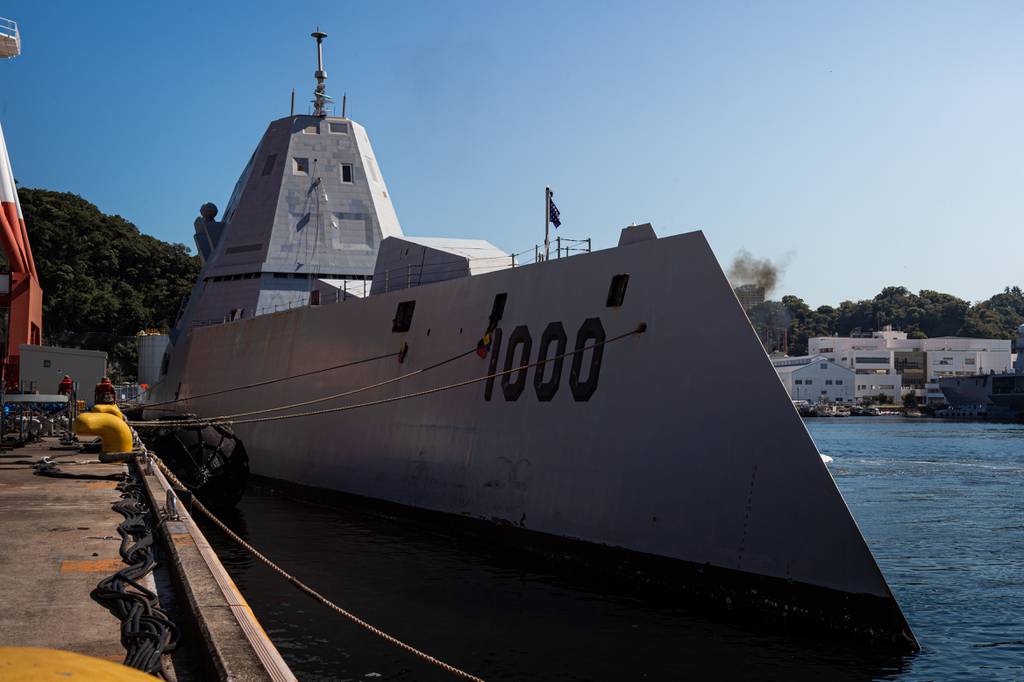
WASHINGTON — The stealth destroyer Zumwalt has returned from three months of operations in the Western Pacific, achieving a number of firsts for the new class of ship even as its primary payload — a hypersonic missile — remains under development.
Zumwalt departed its San Diego homeport Aug. 1 and returned Nov. 10, ship commanding officer Capt. Amy McInnis told reporters Wednesday. After a full year of workups, the ship headed toward Guam and then on to Japan, conducting a number of joint and bilateral training events along the way.
Capt. Shea Thompson, commander of the Surface Development Squadron One that oversees Zumwalt-class concept development and fleet introduction work, told reporters the ship conducted simulated maritime fires training with U.S. Air Force B-1 bombers and the 613th Air Operations Center in Hawaii as well as a Japanese destroyer and the Commander Task Force-71 staff out of Japan. These events, while simulated, helped test the ship’s combat system in U.S. 7th Fleet, the primary theater of operations for this ship class.
Thompson said the ship also conducted air operations with U.S. Army units as well as development work on a novel mine countermeasures concept with a forward-deployed explosive ordnance disposal unit.
“We made significant strides in learning how to employ, integrate and sustain DDG-1000 in the forward environment,” he said.
McInnis noted her crew learned about the ship’s communications systems and its logistics during the deployment, which included the first preventative maintenance availability outside the San Diego homeport.
Thompson said this contractor-led maintenance availability took place in Hawaii and the ship, his squadron and Naval Surface Forces gained a better understanding of what expeditionary maintenance on a Zumwalt destroyer might look like even further from home in the future.
Still, the Zumwalt didn’t get to work on perhaps its most notable mission: hauling hypersonic missiles for the Navy’s conventional prompt strike mission.
The hypersonic missile is nearing fielding next year, first with the U.S. Army using ground-based launchers. The Zumwalt-class will be the Navy’s first foray into using the same hypersonic missile, but with a separate launcher.
Vice Adm. Johnny Wolfe, the head of the Navy’s Strategic Systems Programs office, said earlier this month the Navy had already demonstrated the ability to shoot the weapon out of a missile tube with pressurized air, getting the weapon high enough so it can light off mid-air without damaging the ship below.
Even as development and testing of the missile itself wraps up in the coming year, the Navy is planning a major 18-month maintenance availability for Zumwalt across fiscal years 2024 and 2025 when it will, among other things, have the conventional strike prompt missiles and combat system installed on the destroyer.
Installation will wrap up by late 2025, and Thompson said Zumwalt will then need several months to test its new weapon before heading into a year-long workup cycle and then conducting its first-ever deployment.
The future guided-missile destroyer USS Zumwalt (DDG 1000) departs the Bath Iron Works shipyard in Maine on March 24, 2016, for its second at-sea period to conduct builder’s trials and in preparation for acceptance trials in April. (Christianne Witten/US Navy)
This year’s employment comes after a long string of delays on the program. Builder General Dynamics Bath Iron Works completed a hull and mechanical delivery to the Navy in May 2016, but the ship had no combat system installed. The destroyer sailed around to San Diego in late 2016 for a combat systems activation that wasn’t completed until April 2020.
According to a 2008 Government Accountability Office report, the ship was meant to deliver in 2013 and complete its combat system activation in 2014. That schedule showed the ship reaching initial operational capability in 2015 — something Thompson says the ship reached this month upon completion of its first operational employment, seven years later than previously planned.
During its recent employment, the ship remained under Navy control to focus its operations on crew training and fleet introduction activities. During its first proper deployment, likely in late calendar year 2026 or early 2027, the ship would deploy and then operate under U.S. 7th Fleet and U.S. Indo-Pacific Command leadership.
“We’re putting a lot of resources and effort behind enhancing the surface strike capability on that platform. But again, it’s a multimission warship: it can operate independently, it can operate in a [surface action group], it can operate within a strike group. It’s going to depend on how that fleet commander desires to employ her,” Thompson said.
Megan Eckstein is the naval warfare reporter at Defense News. She has covered military news since 2009, with a focus on U.S. Navy and Marine Corps operations, acquisition programs and budgets. She has reported from four geographic fleets and is happiest when she’s filing stories from a ship. Megan is a University of Maryland alumna.
- Coinsmart. Europe’s Best Bitcoin and Crypto Exchange.Click Here
- Platoblockchain. Web3 Metaverse Intelligence. Knowledge Amplified. Access Here.
- Source: https://www.defensenews.com/naval/2022/11/17/zumwalt-tackles-surface-warfare-basics-in-first-operational-employment/